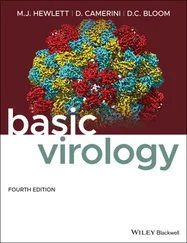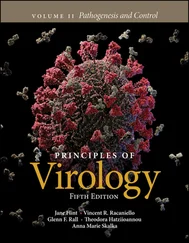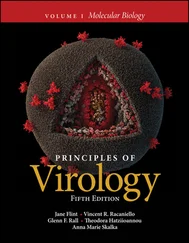Jane Flint - Principles of Virology
Здесь есть возможность читать онлайн «Jane Flint - Principles of Virology» — ознакомительный отрывок электронной книги совершенно бесплатно, а после прочтения отрывка купить полную версию. В некоторых случаях можно слушать аудио, скачать через торрент в формате fb2 и присутствует краткое содержание. Жанр: unrecognised, на английском языке. Описание произведения, (предисловие) а так же отзывы посетителей доступны на портале библиотеки ЛибКат.
- Название:Principles of Virology
- Автор:
- Жанр:
- Год:неизвестен
- ISBN:нет данных
- Рейтинг книги:3 / 5. Голосов: 1
-
Избранное:Добавить в избранное
- Отзывы:
-
Ваша оценка:
- 60
- 1
- 2
- 3
- 4
- 5
Principles of Virology: краткое содержание, описание и аннотация
Предлагаем к чтению аннотацию, описание, краткое содержание или предисловие (зависит от того, что написал сам автор книги «Principles of Virology»). Если вы не нашли необходимую информацию о книге — напишите в комментариях, мы постараемся отыскать её.
Volume I: Molecular Biology
Volume II: Pathogenesis and Control
Principles of Virology, Fifth Edition
Principles of Virology — читать онлайн ознакомительный отрывок
Ниже представлен текст книги, разбитый по страницам. Система сохранения места последней прочитанной страницы, позволяет с удобством читать онлайн бесплатно книгу «Principles of Virology», без необходимости каждый раз заново искать на чём Вы остановились. Поставьте закладку, и сможете в любой момент перейти на страницу, на которой закончили чтение.
Интервал:
Закладка:
11 Chapter 20Table 6.1 Oncogenic viruses and cancerTable 6.2 Some transforming gene products of adenoviruses, papillomaviruses,...
12 Chapter 21Table 7.1 Viral vaccines licensed in the United StatesTable 7.2 When can we expect an HIV vaccine?
13 Chapter 22Table 8.1 Approved drugs targeted against human immunodeficiency virus
14 Chapter 24Table 10.1 Fitness decline compared to initial virus clone after passage thr...
15 Chapter 27Table 13.1 Viroids and satellitesTable 13.2 Some transmissible spongiform encephalopathies
List of Illustrations
1 Chapter 1 Figure 1.1 The human virome. Our knowledge of the diversity of viruses that ca... Figure 1.2 Tracking ancient human migrations by the viruses they carried. The ... Figure 1.3 References to viral diseases from the ancient literature. (A) An im... Figure 1.4 Three Broken Tulips . A painting by Nicolas Robert (1624–1685), now ... Figure 1.5 Characteristic smallpox lesions in a young victim. Illustrations li... Figure 1.6 Pasteur’s famous swan-neck flasks provided passive exclusion of micro... Figure 1.7 The pace of discovery of new infectious agents in the dawn of virolog... Figure 1.8 Filter systems used to characterize/purify virus particles. (A) The... Figure 1.9 Electron micrographs of virus particles following negative staining. ... Figure 1.10 Size matters. (A) Sizes of animal and plant cells, bacteria, virus... Figure 1.11 Lesions induced by tobacco mosaic virus on an infected tobacco leaf.... Figure 1.12 The Baltimore classification. The Baltimore classification assigns... Figure 1.13 Viral families sorted according to the nature of the viral genomes. ... Figure 1.14 Landmarks in the study of viruses. Key discoveries and technical a...
2 Chapter 2 Figure 2.1 The viral infectious cycle. The infectious cycle of poliovirus is s... Figure 2.2 Different types of cell culture used in virology. Confluent cell mo... Figure 2.3 Production of organoids from stem cells. The different germ layers ... Figure 2.4 Production of airway-liquid interface cultures of bronchial epithel... Figure 2.5 Development of cytopathic effect. (A) Cell rounding and lysis durin... Figure 2.6 Growth of viruses in embryonated eggs. The cutaway view of an embry... Figure 2.7 Plaques formed by different animal viruses. (A) Photomicrograph of ... Figure 2.8 The dose-response curve of the plaque assay. The number of plaques ... Figure 2.9 Transformation assay. Chicken cells transformed by two different st... Figure 2.10 Hemagglutination assay. (Top) Samples of different influenza virus... Figure 2.11 Polysome analysis. To study the association of mRNAs with ribosome... Figure 2.12 Direct and indirect methods for antigen detection. (A) The sample ... Figure 2.13 Detection of viral antigen or antibodies against viruses by enzyme... Figure 2.14 Lateral flow immunochromatographic assay. A slide or “dipstick” co... Figure 2.15 Using fluorescent proteins to study virus particles and virus-infe... Figure 2.16 Polymerase chain reaction. The DNA to be amplified is mixed with n... Figure 2.17 Workflow for VS-Virome. Shown is the computational pipeline design... Figure 2.18 Comparison of bacterial and viral reproduction. (A) Growth curve f... Figure 2.19 One-step growth curves of animal viruses. (A) Growth of a nonenvel... Figure 2.20 Chromatin immunoprecipitation and DNA sequencing, ChiP-seq. This t... Figure 2.21 Interactions between human proteins and Nipah virus proteins. Netw... Figure 2.22 Single-cell virology. (A) A microfluidic device with 6,400 wells i...
3 Chapter 3 Figure 3.1 The Baltimore classification. All viruses must produce mRNA that ca... Figure 3.2 Structure and expression of viral double-stranded DNA genomes. (A) ... Figure 3.3 Structure and expression of viral gapped, circular, double-stranded D... Figure 3.4 Structure and expression of viral single-stranded DNA genomes. (A) ... Figure 3.5 Structure and expression of viral double-stranded RNA genomes. (A) ... Figure 3.6 Structure and expression of viral single-stranded (+) RNA genomes. Figure 3.7 Structure and expression of viral single-stranded (+) RNA genomes wit... Figure 3.8 Structure and expression of viral single-stranded (–) RNA genomes. Figure 3.9 Genome structures in cartoons and in real life. (A) Linear represen... Figure 3.10 Information retrieval from viral genomes. Different strategies for... Figure 3.11 Reassortment of influenza virus RNA segments. (A) Progeny viruses ... Figure 3.12 Recovery of infectivity from cloned DNA of RNA viruses. (A) The in... Figure 3.13 Use of RNAi, haploid cells, and CRISPR-Cas9 to study virus-host inte... Figure 3.14 Adenovirus vectors. High-capacity adenovirus “gutless” vectors con... Figure 3.15 Adeno-associated virus vectors. (A) Map of the genome of wild-type... Figure 3.16 Retroviral vectors. The minimal viral sequences required for retro...
4 Chapter 4 Figure 4.1 Variation in the size and shape of virus particles. (A) Cryo-electr... Figure 4.2 Free energy changes in virus particles. Mature virus particles occu... Figure 4.3 Cryo-EM and image reconstruction illustrated with rotavirus. Figure 4.4 Determination of virus structure by X-ray diffraction. This method ... Figure 4.5 Difference mapping illustrated by a 6-Å-resolution reconstruction of ... Figure 4.6 Virus structures with helical symmetry. (A) Schematic illustration ... Figure 4.7 Structure of a ribonucleoprotein-like complex of vesicular stomatitis... Figure 4.8 Structure of an influenza A virus ribonucleoprotein. (A) (Left) Rib... Figure 4.9 Icosahedral packing in simple structures. (A) An icosahedron, which... Figure 4.10 The principle of triangulation: formation of large capsids with icos... Figure 4.11 Structure of the parvovirus adeno-associated virus 2. (A) Ribbon d... Figure 4.12 Packing and structures of poliovirus proteins. (A) The packing of ... Figure 4.13 Interactions among the proteins of the poliovirus capsid. (A) Ribb... Figure 4.14 Structural features of simian virus 40. (A) View of the simian vir... Figure 4.15 Structural features of adenovirus particles. (A) The organization ... Figure 4.16 Interactions among major and minor proteins of the adenoviral capsid... Figure 4.17 Structures of members of the Reoviridae. The organization of mamma... Figure 4.18 Asymmetric capsids of retroviruses. (A) Variation in the morpholog... Figure 4.19 Ordered RNA genomes in small and large icosahedral virus particles. ... Figure 4.20 Packing of double-stranded DNA genome. (A) Dense packing in the he... Figure 4.21 Conserved organization of the RNA-packaging proteins of nonsegmented... Figure 4.22 Structural and chemical features of a typical viral envelope glycopr... Figure 4.23 Structures of extracellular domains of viral glycoproteins. These ... Figure 4.24 Structure of a simple enveloped virus, Sindbis virus. (A) Cross se... Figure 4.25 Conserved topology and regular packing of envelope proteins of small... Figure 4.26 Morphological complexity of bacteriophage T4. (A) A model of the v... Figure 4.27 Structural features of herpesvirus particles. (A) Two slices throu... Figure 4.28 Features of mimivirus capsids. (A) Cryo-EM reconstruction of Cafet ... Figure 4.29 Virus particles with alternative architectures. Structural feature... Figure 4.30 Atomic force microscopy and its application to human adenovirus part...
5 Chapter 5 Figure 5.1 Architecture of cell surfaces. Example of epithelial cells with api... Figure 5.2 Experimental strategies for identification and isolation of genes enc... Figure 5.3 Some receptors for virus particles. Schematic diagrams of cell mole... Figure 5.4 Picornavirus-receptor interactions. (A) Structure of poliovirus bou... Figure 5.5 Structure of the adenovirus 12 knob bound to the CAR receptor. (A) ... Figure 5.6 Entry of polyomavirus simian virus 40. Simian virus 40 interacts fi... Figure 5.7 Interaction of sialic acid receptors with the hemagglutinin of influe... Figure 5.8 Interaction of human immunodeficiency virus type 1 envelope glycoprot... Figure 5.9 Multiple receptors for herpes simplex virus 1 (HSV-1). Six (of 15) ... Figure 5.10 Mechanisms for the uptake of macromolecules from extracellular fluid... Figure 5.11 Virus entry and movement in the cytoplasm. Examples of various rou... Figure 5.12 Conformational changes of class I proteins during fusion. The enve... Figure 5.13 Influenza virus entry. The globular heads of HA trimers mediate bi... Figure 5.14 Conservation of the hairpin structure in class I viral fusion protei... Figure 5.15 Fusion at the plasma membrane. (Top) Model for human immunodeficie... Figure 5.16 Entry of Ebolavirus into cells. Virus particles bind cells via an ... Figure 5.17 SNARE-mediated fusion. The change of syntaxin (t-SNARE, purple) fr... Figure 5.18 Conformational changes in class II proteins during fusion. (A) Nin... Figure 5.19 Conformational changes in class III proteins during fusion. Struct... Figure 5.20 Entry of Semliki Forest virus into cells. Semliki Forest virus ent... Figure 5.21 Stepwise uncoating of adenovirus. (A) Adenovirus fiber proteins bi... Figure 5.22 Model for poliovirus entry into cells. The native virus particle (... Figure 5.23 Entry of reovirus into cells. (A) The different stages in cell ent... Figure 5.24 Structure and organization of the nuclear pore complex. (Bottom le... Figure 5.25 Nuclear localization signals. The general form and specific exampl... Figure 5.26 Different strategies for entering the nucleus. (A) Each segment of... Figure 5.27 Uncoating of adenovirus at the nuclear pore complex. After release...
Читать дальшеИнтервал:
Закладка:
Похожие книги на «Principles of Virology»
Представляем Вашему вниманию похожие книги на «Principles of Virology» списком для выбора. Мы отобрали схожую по названию и смыслу литературу в надежде предоставить читателям больше вариантов отыскать новые, интересные, ещё непрочитанные произведения.
Обсуждение, отзывы о книге «Principles of Virology» и просто собственные мнения читателей. Оставьте ваши комментарии, напишите, что Вы думаете о произведении, его смысле или главных героях. Укажите что конкретно понравилось, а что нет, и почему Вы так считаете.











